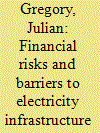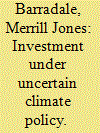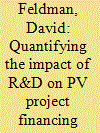|
|
|
Sort Order |
|
|
|
Items / Page
|
|
|
|
|
|
|
| Srl | Item |
| 1 |
ID:
110871


|
|
|
|
|
| Publication |
2012.
|
| Summary/Abstract |
Old-age income protection is provided in wealthy democracies by publicly funded defined-benefit pensions. Budgetary challenges have forced policy makers to consider private alternatives to these traditional systems. I consider the shortcomings of private saving arrangements in duplicating the advantages of public pensions. Some shortcomings can be overcome by introducing compulsory elements into private saving plans. Worker contributions into such plans could be mandatory; some or all worker accumulations in the plans could be converted to annuities at retirement; and workers' investment choices could be narrowly circumscribed. These restrictions do not eliminate the biggest weakness of private saving plans. Fluctuations in asset prices make it hard even for well-informed savers to select an affordable saving rate and an investment strategy that will assure decent income in old age. Public pension systems partly insulate workers against economic and financial market risks by sharing those risks broadly across workers, retirees, and taxpayers in multiple generations.
|
|
|
|
|
|
|
|
|
|
|
|
|
|
|
|
| 2 |
ID:
162968


|
|
|
|
|
| Summary/Abstract |
The recent academic literature contains a number of hypotheses, drivers, or explanations to reveal why electricity infrastructure isn’t being developed within sub-Saharan Africa (SSA) in the 21st century. In this paper, we argue that this literature is misdirected, or at least incomplete, in how it approaches risk. We hypothesise that this lack of infrastructure development in the region reflects a dearth of investment due to the existence of excessive negative uncertainties or risks – as investment is a function of uncertainty and reward – but that the recent academic literature appears to not appreciate this. To make this argument, we chose a manageable sample of three African countries, which already had a notable body of academic literature concerning them: Kenya, Mozambique and Tanzania. Focusing on these countries, we then undertook a systematic review of 815 ‘peer reviewed’ papers published on the academic libraries of Scopus and/or the Web of Science on the topic of electricity, infrastructure, and risk over a five-year period to see how this literature evaluated the problem. Drawing from the most relevant 101 studies within that sample, we critically examine the methodological, conceptual, and empirical aspects of this literature.
|
|
|
|
|
|
|
|
|
|
|
|
|
|
|
|
| 3 |
ID:
132686


|
|
|
|
|
| Publication |
2014.
|
| Summary/Abstract |
This paper introduces the concept of payment probability as an important component of carbon risk (the financial risk associated with CO2 emissions under uncertain climate policy). In modeling power plant investment decisions, most existing literature uses the expected carbon price (e.g., the price of traded permits or carbon tax) as a proxy for carbon risk. In contrast, this paper identifies expected carbon payment as a more accurate measure of carbon risk as perceived by industry practitioners. This measure of carbon risk incorporates both expected price and the probability that this price would actually be faced in the case of a particular investment. This concept helps explain both the surge of activity in 2005-2006 and the subsequent decline in interest in coal-fired power plant development in the U.S. The data for this case study comes from an extensive online survey of 700 U.S. energy professionals completed in 2006, as well as interviews conducted with industry representatives from 2007 to 2009. By analyzing industry views on policy uncertainty and future carbon legislation, we gain a better understanding of investor attitudes toward carbon risk. This understanding will help policy makers design better incentives for investing in low-carbon technologies.
|
|
|
|
|
|
|
|
|
|
|
|
|
|
|
|
| 4 |
ID:
108490


|
|
|
|
|
| Publication |
2011.
|
| Summary/Abstract |
The past few decades have witnessed a fundamental change in the perception of threats to the security of states and individuals. Issues of security are no longer primarily framed in terms of threats posed by an identifiable, conventional enemy. Instead, post-Cold War security policies have emphasised the global and radically uncertain nature of threats such as environmental degradation, terrorism and financial risks. What are the implications of this transformation for one of the constitutive principles of international society: state sovereignty? Existing literature has provided two possible answers to this question. The first focuses on the alleged need for states to seek international cooperation and to relax claims of national sovereignty. In Ulrich Beck's terminology, this would amount to a transformation of sovereign states into 'cosmopolitan states'. The second takes the opposite position: in response to uncertain threats states rely on their sovereign prerogatives to take exceptional measures and set aside provisions of positive law. In Beck's terminology, this would amount to the creation of a 'surveillance state'. None of these two answers, however, does justice to the complex relation between sovereignty, power and (international) law. As this article will show, the invocation of radical uncertainty has led to a transformation in sovereignty that cannot be captured in terms of the cosmopolitan/surveillance dichotomy. What is at stake is a more fundamental transformation of the way in which sovereignty is used to counter threats. Based on a study of the UN Counterterrorism Committee, this article demonstrates how state sovereignty is used as a governmental technology that aims to create proactive, responsible subjects.
|
|
|
|
|
|
|
|
|
|
|
|
|
|
|
|
| 5 |
ID:
176821


|
|
|
|
|
| Summary/Abstract |
Energy technology research and development (R&D) typically focuses on advancing the performance and reducing equipment and installation costs. However, such R&D can also have significant indirect impacts on other factors. Incorporating the impact that R&D activities have on financing costs can provide a more complete picture of the consequences of these decisions, and may allow policymakers to make better decisions. In this paper we discuss some historical examples of R&D impacting financing costs in the solar energy sector, summarize the areas of R&D that can impact financing, and describe methodological approaches that can be used to quantify the impact of R&D on financing costs and, as a result, the levelized cost of energy (LCOE). We estimate that R&D-driven reductions in financing costs in the solar sector, from current levels to low-risk levels, could reduce LCOE approximately 25%. Alternatively, without the R&D advances needed to prevent future risks and complications, financing costs in the solar sector could increase by as much as 115%.
|
|
|
|
|
|
|
|
|
|
|
|
|
|
|
|
| 6 |
ID:
152765


|
|
|
|
|
| Summary/Abstract |
Since the pioneering studies of Mandelbrot, a great deal of interest has arisen for the parameters of fractal finance theory. With this in mind, the present study attempts to examine the risk composition of S&P 500 index industries through panel data analysis. In the modelling of industries’ stock return risk, we use internal and external variables which are related to the companies’ financial ratios and stock market movements. In the first section (sigma-risk) of the study, we model the stock return risk through standard deviation, while in the second section (alpha-risk), the alpha parameter of stable distributions has been used for the same purpose. Panel data analysis results demonstrate that in the sigma-risk model for the healthcare industry, there is a significant internal variable (roa) that negatively affects the industry risk. However, for the alpha-risk model, some significant variables are obtained for the service industry. Another important finding is the changing level of market risk under the two models. While in the sigma-risk model, the magnitude of the market (external) risk variable is high, under the alpha-risk model, we have seen that market risk is relatively low despite the fact that it still has the highest effect on industry risk.
|
|
|
|
|
|
|
|
|
|
|
|
|
|
|
|
| 7 |
ID:
137600


|
|
|
|
|
| Summary/Abstract |
his paper argues that the twin surpluses in China's balance of payments will disappear in the future as a result of external and internal structural changes. China's current account surplus will diminish as a result of the decline in the goods trade surplus, the expanding service trade deficit and negative investment income. China's capital account might shift from surplus to deficit as a result of shrinking net direct investment inflows and more volatile short-term capital flows. When the twin surpluses no longer exist, the normalization of the US treasury bond yields will be sped up, terminating the one-way appreciation of the RMB exchange rate; the People's Bank of China's pressure to sterilize inflows will be alleviated, and new problems for the People's Bank of China's monetary operation will emerge; new financial vulnerabilities for the Chinese economy will arise. Finally, the present paper provides some policy suggestions for the Chinese Government to deal with the declining twin surpluses.
|
|
|
|
|
|
|
|
|
|
|
|
|
|
|
|
|
|
|
|
|